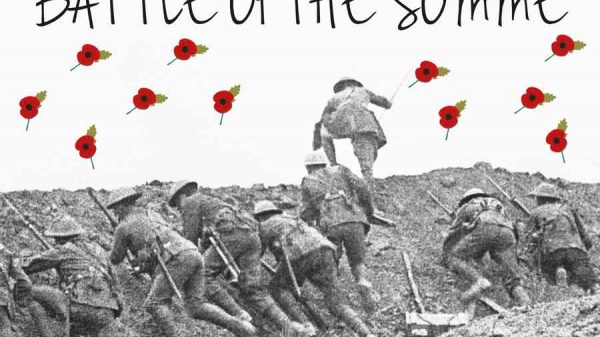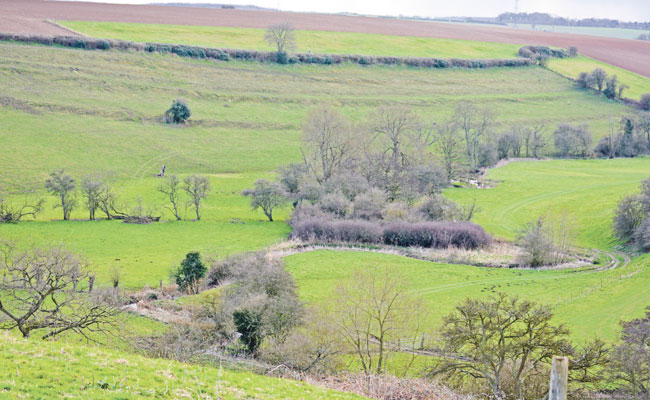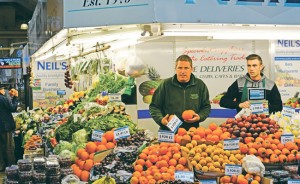Leeds Kirkgate Market is one of the largest indoor covered markets in Europe. It contains over 600 stalls, 400 of which are indoors and 200 of which are outdoor. It contains 250 businesses in all.
Leeds Market was voted Best Shopping Centre in 2011 by the Leeds Retail Awards, and is clearly one of the public’s favourite. Traders in today’s market hustle to sell you fresh yam, crab claws, exotic spices, furnishings, clothes and many other products that cannot be sourced in the larger shopping outlets.
In 1853, though Leeds Market’s history stretches back to the 1200’s, Mr Tilney, the Borough Surveyor of Leeds, travelled the length and breadth of the country looking at design inspiration for the market. One such building caught his attention, Crystal Palace, which was designed by Sir Joseph Paxton who later became adviser to the Borough Council. At a cost of £14,000 the market was built, despite opposition from a number of members of the market committee who left thinking that the building would cause a nuisance to the neighbourhood and that costs could not possibly be recouped.
Leeds is justly proud of the fact that Kirkgate Market was the ‘birthplace’ of a ‘retail institution,’ for it was here that Michael Marks, a Lithuanian Jew, set up a stall in the market calling it a ‘Penny Bazaar,’ with the slogan – ‘Don’t ask the price, it’s a penny.’
This was thanks to a wealthy wholesaler called Isaac Dewhirst who, while walking in Kirkgate one day with an employee, Charles Backhouse, was approached by Marks. He could speak very little English and could only manage to say ‘Barran.’ This was the name of a textile firm known to employ immigrants; Marks was hoping for work with the firm.
Charles Backhouse fortunately could speak a little Yiddish and managed to interpret. Dewhirst was impressed by Marks’ business sense and gave him five pounds credit to spend at his warehouse. That five pounds credit enabled Michael Marks to set up his business. It became so successful he moved to Wigan’s large market in 1891. In 1894 he took on a partner, Tom Spencer. Mark’s and Spencer’s was born, and as the phrase goes, the rest is history.
Another long and successful market business that lasted for years was Archibald Scarr’s. He moved to Leeds from Burnley in Lancashire with his family when he was thirteen and started his working life as a barrow boy selling fruit and vegetables, later moving into the hardware business. Archibald was immensely popular with the working classes and was a well loved character. He was ultimately elected Alderman in 1880 and the Mayor of Leeds in 1887.
There were many colourful characters in Leeds Market and readers may have heard of John Kelly, nicknamed ‘Cheap Jack,’ who was regarded as the star turn of the orators and as having a rather ‘caustic’ sense of humour. Cheap Jack attracted a large audience and claimed that his pink coloured soap would improve one’s complexion. To demonstrate this he would grab a boy from the audience and violently wash him with it and then scrub dry the boy with the brown paper wrapping the soap came in.
Perhaps the best known character was ‘Pie Jack,’ who would call out:
“Pies al’ ‘ot lads, pies al’ ‘ot. Penny each, penny each.’ Jack called them ‘savour trundles.’ He was a rather large man weighing some sixteen stone and was said to be as broad as he was long.
On one occasion a labourer was so pleased with one of the pies, he asked Jack how many it would take to fill him. Jack ‘eyed’ him up and down and said he would give him two bob to see. The labourer then set about the pies and ate a dozen. At this point some of Jack’s regulars were demanding attention. Jack tried to serve them and the labourer said, “ ‘ere, me lad’ he said ‘owd on a minute wal awv done!” Jack by now was regretting his involvement in this, and asked the man how much money he wanted to stop. Jack got the reply “half a dollar.” Jack paid him the ‘half a dollar’ and said to the labourer:
“Well tha licks creation, tha does; “’ow many could tha’ gotten down if a’d let thee?” “Ah sud a bust if I’d etten another,” replied the labourer.
Readers may recall stories of some of the other eccentric traders of years gone by. For instance ‘Doctor Green,’ who used to wear a frock coat and silk hat and would stand behind a green baize covered bench. In front of him were numerous bottles containing worms preserved in spirits. He would give a ‘solemn oration’ in order to try to prove that worms were the curse of mankind. To get rid of the curse was his special prerogative according to him, and in proof of his skill he proudly pointed to the worms, some still wriggling in the bottles. Quite how this was supposed to ‘cure’ was anybody’s guess. His remedy was Doctor Green’s ‘Elixir Pills’ selling at one penny a box.
Although there were few physical changes to the market in the 1900’s, there were changes to the infrastructure. There was a large increase in the volume of trade carried out by the wholesalers, due the fact that Leeds was the half way point between London and Scotland, and midway between the two largest ports of Liverpool and Hull.Leeds became a hugely significant distribution centre, and there were great plans for expansion. However World War II began and the ambitious scheme had to be aborted. The next six years were difficult, air raid shelters were built for tenants and a complete blackout was provided. The Ministry of Food took over various rooms within the building and assisted in regulating the various schemes for the management of food control. The blackout, food shortages and conscription all greatly affected business. On the night of 14th March 1941, Kirkgate Market was bombed and significant damage ensued. Thankfully it recovered.
In the 1950’s and 1960’s trade increased as traders took advantage of the all weather stands. Leeds received increasing supplies of imported fruit and this made for better displays and a larger amount of patrons. The market was now selling produce from all over the world and had over 400 traders and 100,000 shoppers visit every Saturday. However, disaster struck on December 13th 1975, when a mysterious fire broke out. One theory as to its causation was that a paraffin heater exploded, another; a possible electrical fault, however the ‘jury’ is still out as to how it started. Some 100 fire-fighters attended the blaze but after the fire was out the roof fell in. The damage ran into some £7,000,000. Once again it recovered.
The word ‘arguably’ often crops up in conversations, but in the case of Leeds Kirkgate Market describing it as ‘the jewel in the crown’ of Leeds, the word ‘arguably’ is superfluous. It needs to be emphasised that it really is the ‘jewel in the crown’ of Leeds and without it the city would be that much poorer.
Last month we invited readers to contribute their memories of Leeds Market. We have chosen a selection for you to read.
Market memories of 1936
My grandmother used to take me round the market in 1936.I remember some of the stalls,the butchers shops all had rabbits to skin,chickens,ducks and geese to pluck on rails above each shop.Just round the corner a shop sold horse meat,dad bought some steaks.
I remember the pot stalls,a whole tea service being thrown and caught.There was a tatters market at the back(second hand stuff) also you could buy live rabbits,ducks,chickens etc.One day my grandma was shopping in the market and got knocked down by a one legged man on a trolley who used to bring goods to the traders.She never walked properly after that again.Just a few of my memories.
By G.J.Metcalf
Memories of Leeds market early 1940’s
I am 82 years old but remember many things about the Leeds Market.I remember going to Leeds market with my Grandad in the early 1940’s he bought some day old chicks from the pet market right at the bottom end.In the late forty’s my mother who was a war widow took me and my brother to the pet stall to buy a puppy. The puppy made a lovely little dog and we had her for many years.
The outside market was very interesting with many different characters,There was Mr Dowson who sold curtains,towels and he sometimes wore a leg like Tommy Cooper.Mr Rhodes who sold China plates and cups.He would ask a price for a couple of plates,if he didn’t get a response he would throw them in the air,catch them,then smash them and say “ I’m not giving them away”
Woodbine Lizzy a well known character I remember used to go around the market I think she got the name because she would cadge woodbine off people. She wore an old tram drivers hat and a couple of coats always carried a bag, I think she was given fruit from the stall holders.
Many years later my wife worked in the main market in Tobins shoe shop and was there longer than most of the other staff so she remembers her market days too.
By Mr R Leadbeater
Memories of Leeds market in the 1950’s
Years ago I lived in Quarry Hill Flats.Leeds Market was just across the road from our flat so the market was almost like a huge corner shop for my family. Mum and Gran would shop there practically on a daily basis.My fondest memory was of a weekly treat at Mrs.Pope’s pie & pea stall,a saucer of mushy peas swamped with mint sauce eaten slowly whilst Mum stood by waiting for me to finish,she always seemed slightly embarrassed I can’t think why.The other stall I remember well was Jack’s fabric stall.Mum worked in the tailoring trade so Jack’s was the place to go for remnants of worsted,gaberdine & other materials and she was able to make most of my clothes,I was very lucky.I also remember my Gran shopping in what was always called “back o’ t market”.She was feeling some fruit which the stall holder ,not surprisingly,took exception to.Gran,a feisty lady,put both hands under the table top and heaved ,not enough,thank goodness,to upend all the goods but certainly to shake them about a bit.I was told the air was blue & the stall holder was not the only guilty party.I often pause as I go through the market to look upwards.The metal work is painted in brilliant colours,bright red dragons support a vivid balcony,coloured & decorated pillars hold up the roof,I love it.I also love the fish market,the stalls have such a variety of fish so beautifully displayed it’s a pleasure to see,long may it continue.One old character I vaguely remember was known as Woodbine Lizzie who would wander round the market this must have been in the 50’s.Perhaps some one else remembers her.
By Deirdre McLean
Memories of Leeds market from the 60’s onwards
Leeds Market has been in my blood for most of my life. As a child a trip into Leeds was exciting and we loved hunting for bargains in the market. My grandparents sold Household Linens, Underwear and Stockings in the open air market on George Street between the wars. The next door stall was Mr Rhodes who sold pottery. His trick to keep the punters interested was to arrange plates and other pieces along one arm saying ‘I’ll give you 6 of these and 6 of these, and throw in 6 of these.’ He’d then give you a price and throw the whole lot onto his other arm. I never saw him drop anything.
Just after the war I can remember a man with an old valve radio on a stand, selling a small box with wires. One of the wires was wound round the blade of a screwdriver and stuck into the ground between the kerb stones. The idea was that it would improve reception. People did buy them though his demonstration wasn’t that convincing!
In 1961 I met my wife to be who worked for a retailer called S.R Stalls who had a shop on Vicar Lane and three stalls in the market. I was offered a job and started selling curtains and household linens. I worked there for 25 years and the only reason my employment ceased was that the owner, and the best employer I have ever had, decided to retire and ceased trading. After this I continued to work in fabric for Stanmore’s, where I stayed until I retired in 2003.
In 1970, the shop on Vicar Lane that the company owned was pulled down for re-development. We decided to look for new premises at the top end of the market. We secured Scarrs, General Hardware and Ironmongers, who also had a shop in New York Street that is now occupied by the Post Office. This took a few months to open and we were the largest stall in the market. The market was very busy and we had to take on extra staff on Saturday’s. 15 months later we had a fire.
During a normal Saturday in 1975, I was returning back to the stall where I worked and there was a glow in the sky close to the market. As I got nearer I could see it was bad, and so I parked across the other side of Eastgate and walked towards the market. I could now see how bad it was and could only think about my boss who was inside. Thankfully he was OK and had got out all right. Lower down in the market, flames were shooting up from inside a small shop. At that time, the roof had long ventilators made of wood running down the roof. Flames were reaching these and spreading quickly. I’ve not ever seen an official report as to what actually happened but the rumour that circulated in the market was that a Calor-Gas stove had been left on igniting aerosol cans. At 10.30pm many of the traders gathered to see what the damage was. What a shock, just ash and rubble as far as we could see. Nothing was recognisable and many of the traders were in tears having lost everything and never returned.
By Barrie Farman
Memories of the Leeds market fire 1975
On the night of the fire I was in my local pub, the Middleton Arms, having been told of the fire at the market myself and a few mates went round to the Middleton Park which was only two minutes round the corner. From there it is possible to look over the Leeds city centre, and quite clearly we could see the massive flames engulfing the market building, the flames were really massive and reaching out to the sky at great heights. At the time I was an apprentice roofer at H&W Parker roofing contractors. The following Monday myself and work mates were sent to the Market to start re-roofing the butchers stall area it was possible to start work there straight away as there was no structural damage done to the roof trusses . While we were working there elsewhere the firemen were still damping down the fire and hot ashes. After a couple of hours work the police on sight were giving big joints of meat away that were defrosting in the big fridges due to no electric supply, I got a nice size joint and so did my brother Graham who was working with me, we was told that most of the meat was given out to charity and such. I can’t remember if it was that same Monday or the following day that Prince Charles came to visit the market to see the fire damage , so due to a fire damaged building I got to see and stand next to Prince Charles. All pretty exciting stuff,,,,,
By Stephen Holmes
Woodbine Lizzie – we have heard from many many readers about her
Woodbine Lizzie, formally named Alice Porter, was famous in and around Leeds Market in the 1930’s. Also known as Tramway Lizzie because of her old tram conductor’s hat that she wore as a protection against the elements along with her many layers of coats, Lizzie would cadge Woodbine cigarettes from passers-by who were rewarded with her famous temper if they refused. Lizzie was said to have become addicted to cigarettes during the First World War, when she started smoking a pipe.
Lizzie was born in 1887 in Stanningley Leeds to her labourer father, Frederick Porter and mother, Priscilla Porter. Alice started work at the age of 12, and at the age of 13 years she worked as a worsted spinner, earning 3 shillings and 6 pence. At 18 years she married James Richard Hartley and had 6 children. Having set up home in Pudsey after 12 years, the couple separated and Alice returned to the care of her mother before deciding that she wanted a ‘life outdoors’ on the streets of Leeds. Lizzie could regularly be seen in the doorway of The Whip on Duncan Street and spent her nights resting on Woodhouse Moor or at the back of the Seaman’s Mission on The Calls. Lizzie sadly died in 1947 at Stanley Royd Hospital. She was approximately 60 years of age.







